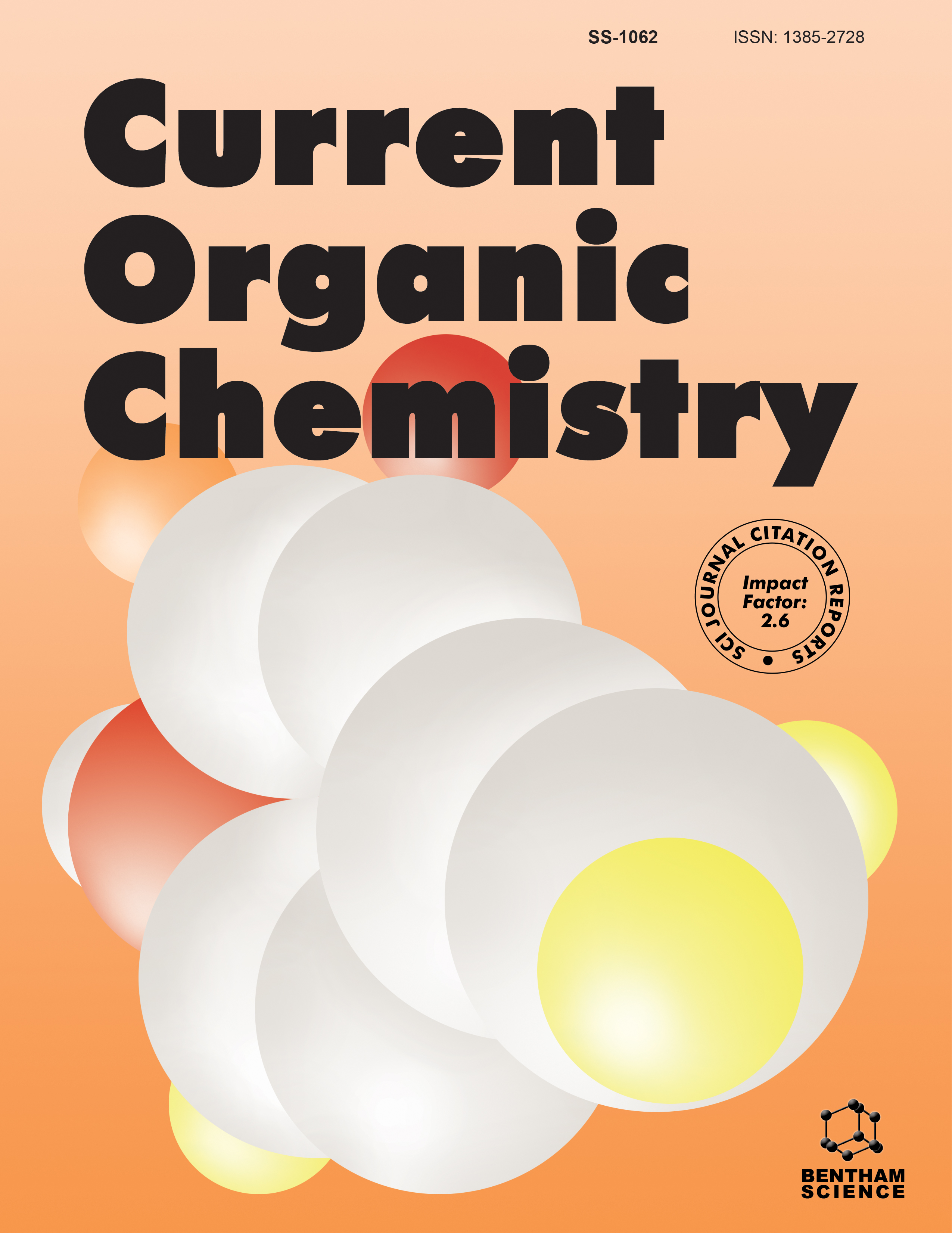- Home
- A-Z Publications
- Current Organic Chemistry
- Previous Issues
- Volume 21, Issue 20, 2017
Current Organic Chemistry - Volume 21, Issue 20, 2017
Volume 21, Issue 20, 2017
-
-
1,4-Dihydropyridines as Tools for Mitochondrial Medicine Against Oxidative Stress and Associated Metabolic Disorders
More LessBackground & Objective: Various 1,4-dihydropyridines (DHPs) could affect basic and cell-type specific mitochondrial functions in different way and at various extent either as protectors or as harmful compounds, depending on their lipophylicity and chemical modifications of the DHP nucleus. Hence, several DHPs may affect: 1) mitochondrial bioenergetics as well as enzymatic activities including electron transport chain reactio Read More
-
-
-
New Prospective for Redox Modulation Mediated by Organo selenium and Organotellurium Compounds
More LessBackground: The growing interest on the redox modulation in living systems broadly involved selenium derivatives that during the last twenty years were often claimed powerful antioxidants but that were also clearly correlated to several important biological effects sometimes, unfortunately, associated to a certain toxicity. Comparing the antioxidant activity of different organoselenium structures it can be observed that someti Read More
-
-
-
Nitrones: A Potential New Alternative as Therapeutic Agents
More LessBackground: Nowadays, nitrones are the most used spin traps to characterize free radicals in biological systems due to the versatility and variety depending on the types of radicals to study and that the halflives of the species studied and/or detected increase considerably. In recent years, nitrones have been studied not only as free radical spin traps. Moreover, nitrones have been employed as therapeutic agents; in particul Read More
-
-
-
Recent Studies and Biological Aspects of Substantial Indole Derivatives with Anti-cancer Activity
More LessBy Sibel SuzenBackground: All cancers are leading causes of morbidity and mortality worldwide. The urgent need for new lead compounds for the treatment of cancer is higher than ever before. Scientists search and try to discover effective but less harmful new anti-tumor agents. Surgery, chemotherapy and radiation are the bestknown methods for treating cancer, however, they continued to be limited. Rising efforts of the scientists towa Read More
-
-
-
Melatonin and Related Compounds: Chemical Insights into their Protective Effects Against Oxidative Stress
More LessAuthors: Annia Galano, Dun-Xian Tan and Russel J. ReiterBackground: Oxidative stress (OS) arises when the balance between the production of oxidants and their removal is disturbed; OS is associated with a wide variety of health disorders. Finding strategies that efficiently reduce OS is an active area of research. Objective: This review summarizes the chemical insights concerning the antioxidant capacity (AOC) of melatonin and related compounds. Method: We consider not only natural Read More
-
-
-
Antioxidant Properties of Pyrimidine and Uracil Derivatives
More LessAuthors: Irena Kostova and Petar Y. AtanasovBackground: Free radicals are frequently generated in vivo and their reactivity varies causing different damages to biological molecules, e.g. DNA, lipids, and proteins. Oxidative stress in the human body is due to the free radicals generation and to the reduced level of antioxidants. Antioxidants are able to reduce the risk for chronic diseases. Hence, natural and synthetic antioxidants may be predominantly significant in diminishi Read More
-
-
-
Analytical Tools for the Determination of Antioxidants and Antioxidant Capacity in Biological Samples, Principles and Applications
More LessBackground: There are two types of antioxidants -high molecular weight antioxidants like glutathione peroxidase and superoxide dismutase and low molecular weight antioxidants like ascorbic acid, glutathione, uric acid, melatonin. Both types of antioxidants are necessary in the system keeping oxidative homeostasis and protecting against reactive oxygen and nitrogen species. Objective: This review is focused on low molecular Read More
-
-
-
Effects of Proteoglycans on Oxidative/Nitrative Stress
More LessAuthors: Marta Sarkozy, Renata Gaspar, Kamilla Gomori, Laszlo Dux, Csaba Csonka and Tamas CsontObjective: Enhanced production of reactive oxygen and/or nitrogen species in biological tissues leads to oxidative and nitrative stress, a general pathophysiological phenomenon playing a role in the development of various human diseases including cardiovascular and neurological disorders. Method: Reactive oxygen and/or nitrogen species interact with lipids, DNA and proteins via oxidative or radical- mediated reactions, pote Read More
-
-
-
Natural Quinones: Antioxidant and Antiaggregant Action Towards Glyceraldehyde-3-Phosphate Dehydrogenase
More LessBackground: Previously, it was demonstrated that quinoid pigments of sea urchins exhibit antioxidant properties. Objective: The work presents a comparative investigation of the antioxidant and antiaggregant action of polyhydroxy- 1,4-naphthoquinones: echinochrome A, spinochrome B, spinochrome C, spinochrome E, echinamine B, histochrome. The glycolytic enzyme glyceraldehyde-3-phospate dehydrogenase (GAPDH) Read More
-
Volumes & issues
-
Volume 29 (2025)
-
Volume 28 (2024)
-
Volume 27 (2023)
-
Volume 26 (2022)
-
Volume 25 (2021)
-
Volume 24 (2020)
-
Volume 23 (2019)
-
Volume 22 (2018)
-
Volume 21 (2017)
-
Volume 20 (2016)
-
Volume 19 (2015)
-
Volume 18 (2014)
-
Volume 17 (2013)
-
Volume 16 (2012)
-
Volume 15 (2011)
-
Volume 14 (2010)
-
Volume 13 (2009)
-
Volume 12 (2008)
-
Volume 11 (2007)
-
Volume 10 (2006)
-
Volume 9 (2005)
-
Volume 8 (2004)
-
Volume 7 (2003)
-
Volume 6 (2002)
-
Volume 5 (2001)
-
Volume 4 (2000)
Most Read This Month
Article
content/journals/coc
Journal
10
5
false
en


